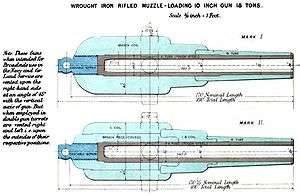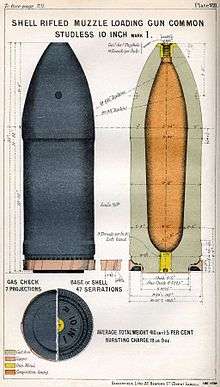RML 10 inch 18 ton gun
| Ordnance RML 10 inch 18 ton gun | |
|---|---|
|
Mk I gun on broadside ironclad HMS Sultan in the 1890s | |
| Type |
Naval gun Coastal gun |
| Place of origin | United Kingdom |
| Service history | |
| In service | 1868 - 19?? |
| Used by |
Royal Navy Australian Colonies |
| Wars | Bombardment of Alexandria (1882) |
| Production history | |
| Designer | M Robert Fraser, Royal Gun Factory |
| Designed | 1868 |
| Manufacturer | Royal Arsenal |
| Unit cost | £1006[1] |
| Variants | Mks I - II |
| Specifications | |
| Barrel length | 145.5 inches (3.70 m) (bore)[2] |
|
| |
| Shell | 400 to 410 pounds (181.4 to 186.0 kg) Palliser, Common, Shrapnel |
| Calibre | 10-inch (254.0 mm) |
| Muzzle velocity |
Palliser : 1,364 feet per second (416 m/s) Common & shrapnel : 1,028 feet per second (313 m/s)[3] |
| Maximum firing range | 6,000 yards (5,500 m) |
The RML 10 inch guns Mk I - Mk II were large rifled muzzle-loading guns designed for British battleships and monitors in the 1860s to 1880s. They were also fitted to the Bouncer[4] and Ant-class flat-iron gunboats.
Design

The 10-inch gun was a standard "Woolwich" design (characterised by having a steel A tube with relatively few broad, rounded and shallow rifling grooves) developed in 1868, based on the successful Mk III 9-inch gun, itself based on the "Fraser" system. The Fraser system was an economy measure applied to the successful Armstrong design for heavy muzzle-loaders, which were expensive to produce. It retained the Armstrong steel barrel surrounded by wrought-iron coils under tension, but replaced the multiple thin wrought-iron coils shrunk around it by a single larger coil (10 inch Mark I) or 2 coils (Mark II); the trunnion ring was now welded to other coils; and it eliminated Armstrong's expensive forged breech-piece.[5]
The gun was rifled with 7 grooves, increasing from 1 turn in 100 calibres to 1 in 40.[2]
It was first used for the main armament on the central battery ironclad HMS Hercules, completed in late 1868.
A number of the Mk I guns on HMS Hercules and one of the two damaged guns in HMVS Cerberus suffered from cracked barrels.[6] Presumably this is why only a few (at least 25) Mk I guns were made.
Ammunition
When the gun was first introduced projectiles had several rows of "studs" which engaged with the gun's rifling to impart spin. Sometime after 1878, "attached gas-checks" were fitted to the bases of the studded shells, reducing wear on the guns and improving their range and accuracy. Subsequently, "automatic gas-checks" were developed which could rotate shells, allowing the deployment of a new range of studless ammunition. Thus, any particular gun potentially operated with a mix of studded and studless ammunition.
The gun's primary projectile was "Palliser" shot or shell, an early armour-piercing projectile for attacking armoured warships. A large "battering charge" of 70 pounds "P" (pebble) or 60 pounds "R.L.G." (rifle large grain) gunpowder[7] was used for the Palliser projectile to achieve maximum velocity and hence penetrating capability.
Common (i.e. ordinary explosive) shells and shrapnel shells were fired with the standard "full service charge" of 44 pounds "P" or 40 pounds R.L.G. gunpowder,[7] as for these velocity was not as important.

Studded shell without gas-check. Southsea Castle UK 
Studded shell without gas-check. Southsea Castle UK 
Studless Palliser shell, 410 lb, 1886 
Studless Common shell, 410 lb, 1886 
Studless Shrapnel shell, 410 lb, 1886
See also
Surviving examples

- 4 guns submerged near the remains of HMVS Cerberus in Half Moon Bay, Victoria, Australia (3 x Mk I & 1 x Mk II)
- Damaged Mk I gun No. 17 from HMVS Cerberus is on display at HMAS Cerberus Victoria, Australia
- Mk II gun No. 67 at Southport Gates, Gibraltar
- A Mk II gun at Parson's Lodge Battery, Gibraltar
- Mk II No. 273 at Almeda Gardens, Gibraltar
- Mk II guns Several guns at Fort St Catherine, St George's Island, Bermuda (at least three are Mk II guns)
- A Mk II at the Citadel, Quebec City, Canada
- A single gun at Chapel Bay Fort, United Kingdom
One 10 inch Mk I Common Shell, one 10 inch Mk II Common Shell & one 10 inch Mk III Palliser Shot as part of the Victorian Navy display at the Geelong Maritime Museum, Australia. Details
Various other guns are mounted or unmounted in Bermuda, with some lying outside of Fort St Catherine, having been rolled out when made obsolete (the guns actually mounted on display there were taken from other forts, notably Fort Albert), and a number having been found buried in the moat of Fort Cunningham (the two mounted at Fort George are the RML 11 inch 25 ton gun). At least one has been erected on a display stand at Fort Hamilton, though the original mount is missing, and another at Alexandia Battery.
Notes and references
- ↑ Unit cost of £1005 10 shillings 2 pence is quoted in "The British Navy" Volume II, 1882, by Sir Thomas Brassey. Page 38
- 1 2 Treatise on Construction of Service Ordnance 1877, page 292
- ↑ 1,364 feet/second firing 400-pound projectile with "Battering charge" of 70 pound "P" (gunpowder). Treatise on Construction of Service Ordnance 1877, page 348. 1,028 feet/second firing 410-pound common shell with gas-check with 44 pounds "P" (gunpowder). Victorian Navy Handbook 1887, page 211.
- ↑ Paloczi-Horvath, George (1996). From Monitor to Missile Boat Coast Defence Ships and Coastal Defence since 1860. Conway Maritime Press. p. 27. ISBN 0-85177-650-7.
- ↑ Treatise on Construction of Service Ordnance 1877, page 92-93
- ↑ HMVS Cerberus website. reports of cracked guns
- 1 2 Treatise on Ammunition 1877, page 220
Bibliography
- Treatise on the construction and manufacture of ordnance in the British service. War Office, UK, 1877
- Treatise on Ammunition. 2nd Edition 1877. War Office, UK.
- Manual for Victorian naval forces 1887. HMVS Cerberus website
- Treatise on Ammunition, 4th Edition 1887. War Office, UK.
- Sir Thomas Brassey, The British Navy, Volume II. London: Longmans, Green and Co. 1882
- Handbook for the 10-inch rifled muzzle-loading gun of 18 tons, 1899 at State Library of Victoria
- "Handbook for the 10-inch R.M.L. Guns (Land Service)", 1903, London. Published by His Majesty's Stationery Office at State Library of Victoria
External links
| Wikimedia Commons has media related to RML 10 inch 18 ton Gun. |
- Diagram of gun on Casemate Traversing Platform, at Victorian Forts website
- Diagram of gun on Dwarf "D" Pivot mounting, at Victorian Forts website
- Diagram of gun on 7 foot Parapet "C" mounting, at Victorian Forts website
- Diagram of gun on 7 foot Parapet "C" Long Range mounting, at Victorian Forts website
_10-inch_gun.jpg)